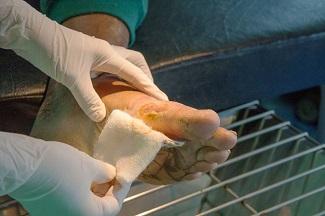Chronic Wound Breakdown: Most Common Types of Chronic Wounds
March 22, 2019
In approaching the management of a chronic wound, the first step in developing a treatment plan that will combat chronicity and promote healthy healing of damaged tissue begins with understanding the different types of wounds. Some of the more common types of chronic wounds include the following:
Venous Ulcers
Venous ulcers can also be referred to as stasis, insufficiency, or varicose ulcers, and they develop when the valves inside the veins of the lower extremities do not work sufficiently, resulting in backflow This process leads to blood pooling in the veins, followed by swelling and the development of an ulcer.1 These ulcers appear in the gaiter area of the leg, above the malleolus to one inch below the knee, as shallow but large wounds with irregular borders.
Venous ulcers can be caused by any condition that leads to blood pooling in the veins of the leg. Causes and risk factors for these ulcers may include varicose veins, deep vein thrombosis, heart failure, diabetes mellitus, peripheral vascular disease, pregnancy, and obesity. Treatment commonly includes debridement or compression therapy.2 At-risk patients may limit their risk by increasing movement to prevent pooling, quitting smoking, elevating their legs above their heart, and managing comorbidities such as high cholesterol, high blood pressure, and obesity.
Arterial Ulcers
Arterial, or ischemic, ulcers are caused by poor perfusion of nutrient-rich blood to the lower extremities that leads to tissue damage as the tissue becomes oxygen deprived. These ulcers are often located between or on the tips of the toes or outer ankle, have a punched-out appearance, and are pale pink, gray, or yellow. Periwound edema may be present, and they are typically full-thickness, causing the patient to feel pain.3 Causes and risk factors for the development of arterial ulcers include peripheral vascular disease and vascular insufficiency, vasculitis, diabetes mellitus, renal failure, high blood pressure, arteriosclerosis, atherosclerosis, trauma, increased age, foot deformity and callus formation, obesity, and limited joint mobility.
Treatment for these ulcers focuses on the restoration of adequate circulation, via angioplasty or with surgical revascularization with interventions such as bypass grafting. Boots and pumps may also be used to assist with perfusion. Patients at higher risk may be advised to quit smoking, exercise more, manage their comorbidities, and avoid staying in the same position (sitting or standing) for an extended period of time.
Diabetic (Neuropathic) Foot Ulcers
Neuropathic foot ulcers are the result of the loss of peripheral sensation, or local paresthesias, in patients with diabetes. This loss of sensation causes extended microtrauma, the breakdown of overlying tissue, and the eventual formation of an ulcer.4 The ulcer is generally painless and most commonly forms below the ankle on the plantar aspect of the foot. It is round, with calloused edges and a partial- or full-thickness. The ulcer’s coloring is generally pale and pink, and it is dry. Causes and risk factors for neuropathic ulcers include primary neurological conditions, alcohol-related neuropathy, renal failure, spinal abnormalities, trauma or surgery, uncontrolled blood glucose concentrations, hypertension, foot deformities, hypercholesterolemia, and kidney disease. Treatment includes managing foot care, debriding the wound, and reducing the pressure on the affected area. Amputation may become necessary in severe cases. At-risk patients should take precautions to control their diabetes, inspect their feet daily, and ensure they have proper footwear.3
Pressure Injuries/Ulcers
Pressure injuries are localized areas in which there is tissue damage resulting from prolonged pressure, shear, or friction, usually on bony prominences, that causes the tissue to compress. These injuries are frequently found on the coccyx and sacrum, heels, elbows, shoulder blades, knees, ankles, the back of the head, or on the spine.1 Their shape and size vary depending on the level of friction and shear, and coloring varies depending on the level of tissue damage. Stage 1 pressure injuries manifest with a different temperature than surrounding tissue, a different consistency, and possibly more tenderness than adjacent tissue.4
Stage 2 ulcers are shallow with a reddish base, and blistering is common in this stage.5 Stage 3 and stage 4 pressure ulcers have much deeper involvement of the underlying tissue. They are full-thickness, and stage 4 ulcers may extend into the muscle, tendon, or even bone.7 Risk factors for these types of wounds include immobility or limited mobility, spinal cord injury, conditions that affect blood flow, fragile skin, incontinence, poor nutrition, dehydration, decreased mental awareness, obesity, neuropathy, fever, anemia, infection, ischemia, hypoxemia, and neurological disease. Treatment includes the frequent turning and repositioning of immobile patients, keeping the skin dry and clean, ensuring adequate nutrition, and engaging in proper levels of activity.4
Conclusion
Understanding how these types of chronic wounds differ and their root causes is essential to determine the most appropriate and effective course of treatment for optimal healing and best clinical outcomes.
References
1. DeKalb Medical. Common types of chronic wounds. http://www.dekalbmedical.org/our-services/wound-care/chronic-wounds/typ…. Accessed February 21, 2019.
2. Gabriel A. Vascular Ulcers. Medscape Reference. http://emedicine.medscape.com/article/1298345-overview. Updated Mar 16, 2016. Accessed March 28, 2019.
3. Cleveland Clinic. Lower Extremity (Leg and Foot) Ulcers. Cleveland Clinic. http://my.clevelandclinic.org/heart/disorders/vascular/legfootulcer.aspx. Published August 17, 2017. Accessed March 28, 2019
4. Salcido R. Pressure Ulcers and Wound Care. Medscape Reference. http://emedicine.medscape.com/article/319284-overview#aw2aab6b2. Updated June 11, 2018. Accessed March 28, 2019.
5. Merck Sharp & Dohme Corp. Pressure Ulcers. The Merck Manual.http://www.merckmanuals.com/professional/dermatologic_disorders/pressure.... Updated July 2017. Accessed March 28, 2019.
The views and opinions expressed in this content are solely those of the contributor, and do not represent the views of WoundSource, HMP Global, its affiliates, or subsidiary companies.










